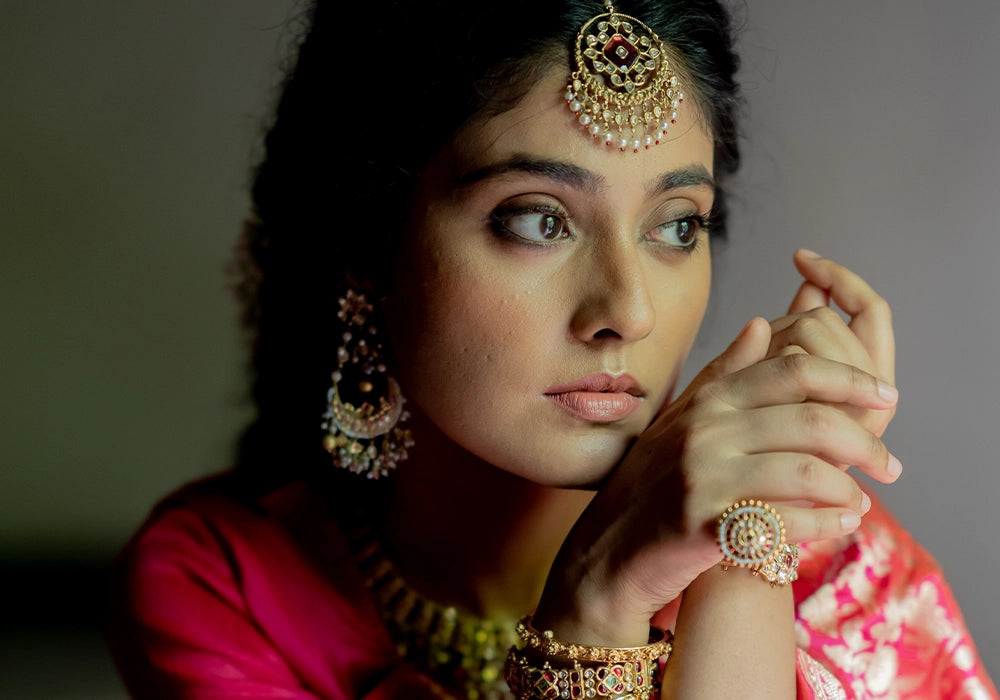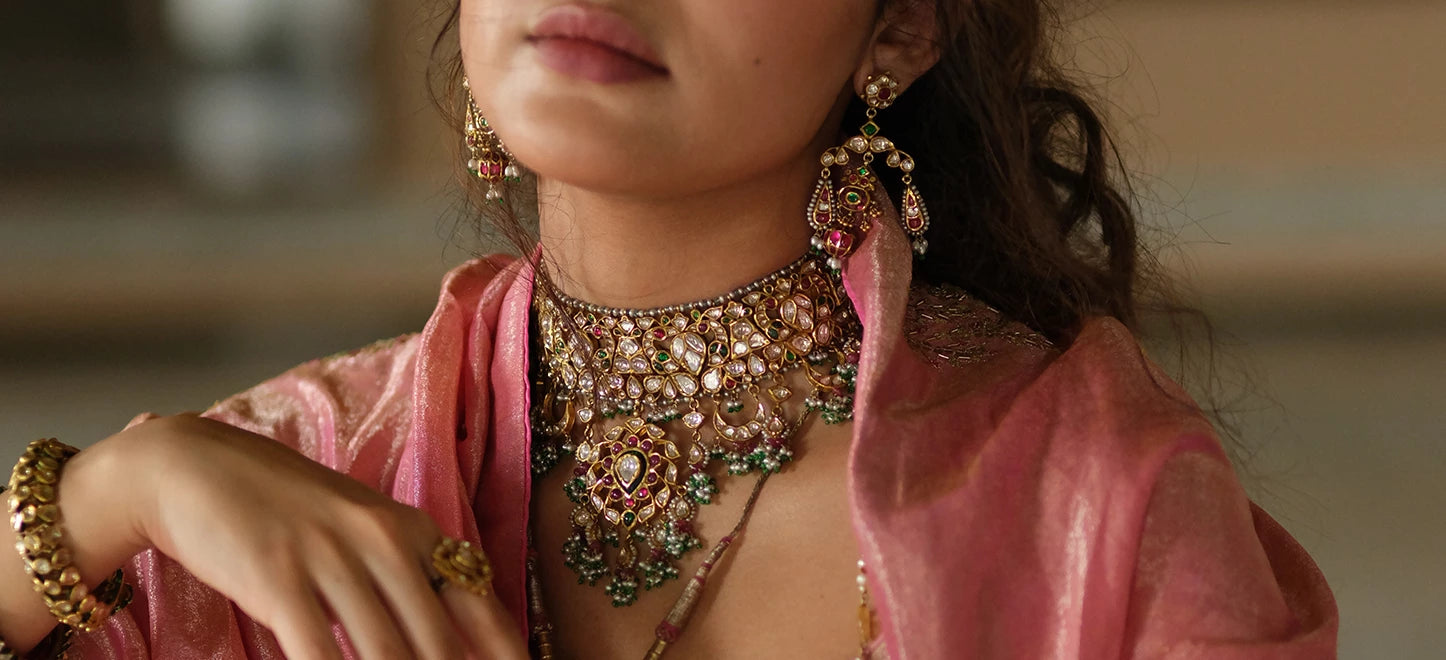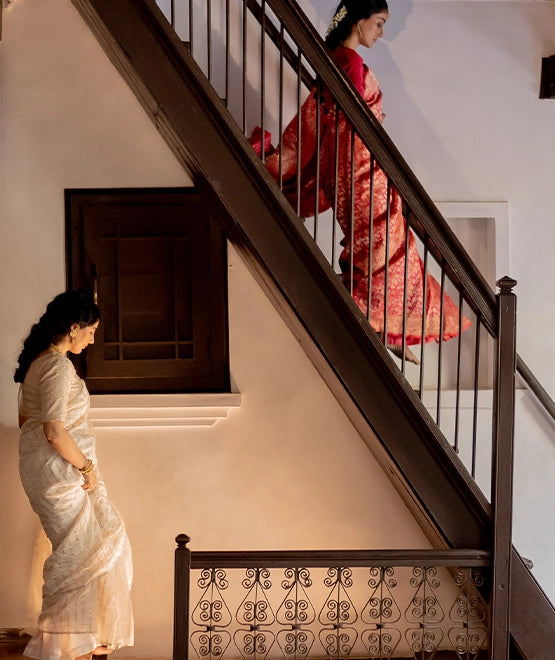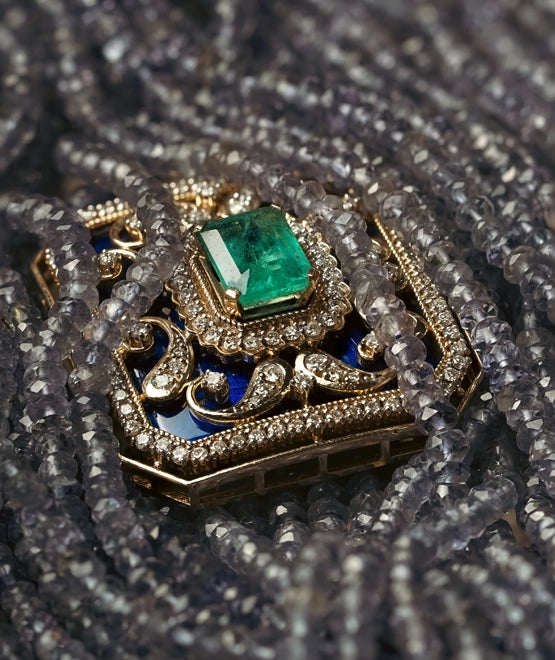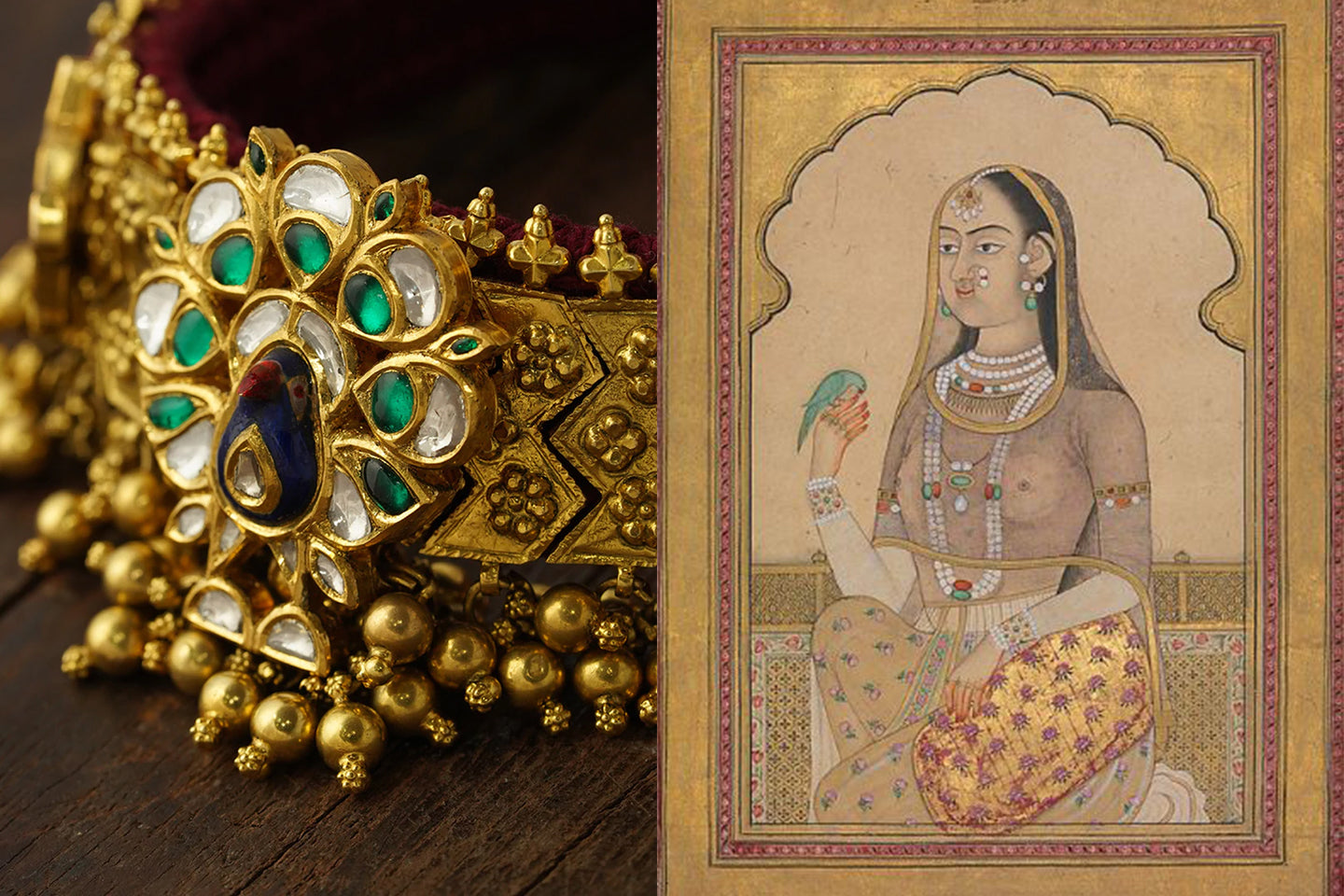Amongst other contemporized forms originally deep-rooted in Indian heritage, birds make a frequent appearance in our designs! We love how the bird motifs have been used over time and still continue to be iconic and representative of India.
Textile
Kanjivaram
Kili (Parrot) - The parrot has always played an important role in Tamil culture, representing truth and the transmission of the teachings of sages. According to ancient literature, Sage Suka and Sage Arunagirinathar took the form of a parrot to recite and record some of the greatest slokas. Adorning the favorite goddesses of the South, Meenakshi and Andal, this motif is also associated with the God of Love – Kama. No wonder this motif finds a place in the bridal trousseau, not only in the kanjivaram, but also in Paithani and Patola sarees. In the South, parrots are also used by astrologers to tell fortunes, emphasizing the connotations of the bird with greater truths. Not only the shape, but the distinctive green color of the parrot—kili pachhai—is also a favorite of the kanjivaram.
Mayil (Peacock) - Peacocks are associated with royalty and regal pomp. It is interesting to note that in the Bible’s Old Testament peacocks are referred to as ‘thukkiyam’ (in Hebrew), and the root word is derived from the Tamil word ‘thogai’ which refers to the peacock. The national bird is also associated with the worship of Murugan, who is depicted on a peacock vahana or vehicle. Yaperungala Vriti, a 12th century text, describes the city of Kanchipuram as a peacock. Athiyur, the place where the Varadharajaswamy temple is located, is referred to as the head of the peacock, while the Shaiva Kanchi temple forms the body. It’s no wonder that this deeply rooted symbolism paved the way for the famous ‘mayil chakaram’ motif in the kanjivaram.
Also read: 8 Fascinating Reasons People Like Custom Fine Jewelry

A saree with “hunting scenes”. Gold and silk brocade on silk; Varanasi. c. early 19th century. This purple or uda-colored gold brocade saree is characterized by the woven embellishments—a variety of hunting animals—the tiger, peacock, deer, elephant, and parrot—bound within a floral jungle or mesh. Image courtesy: National Crafts Museum
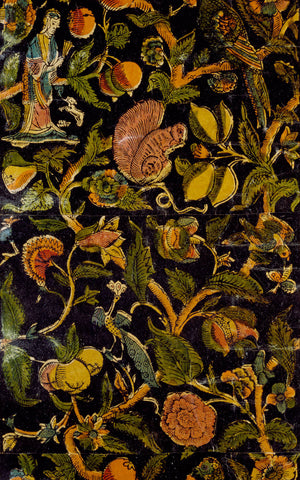
Portion of wallpaper forming a repeat pattern of squirrels, peacocks, parakeets and chinoiserie figures among flowers and foliage, unknown maker, about 1700, hung in Ord House, Berwick-on-Tweed, Northumberland, made in England. Museum no. E.5311-1958. Image courtesy: Victoria and Albert Museum, London

Textile with Animals, Birds, and Flowers late 12th–14th century Eastern Central Asia. Image courtesy: The Met Museum
This textile demonstrates the longevity of motifs in eastern Central Asia. The placement of animals—a spotted horse, a rabbit, and two deer (or antelope)—at its cardinal points is a compositional device that began to appear in the region during the Han dynasty. The birds on the piece, especially the parrot, entered the Central Asian repertoire during a second period of strong Chinese influence, the Tang dynasty. The floral background's central motif of lotus blossoms, a lotus leaf, and a trefoil leaf was seen in Central Asia and North China but became widespread during the Yuan dynasty.

Peacock and Dragon, 1878. designed by William Morris (British, 1834-1896). Image courtesy: The Cleveland Museum of Art
Morris sought to produce textiles that could function as he imagined medieval wall hangings had, bringing warmth to stone-cold rooms. Boldly designed with soothing colors in thick wool, Peacock and Dragon is the closest Morris came to achieving this ideal. In the same year he designed this textile, Morris visited the shop of the London dealer Vincent Robinson, where he saw a room re-created from Damascus, “all vermillion and gold and ultramarine, very beautiful, and is just like going into the Arabian nights.” It partly inspired the exotic motifs seen here. This design was one of the most popular among Morris’s customers; it was available in five colorways.
Art

Tutinama by Indischer Maler. Image courtesy: Wikipedia
Tutinama translates to "Tales of a Parrot", and is a 14th-century Persian series of 52 stories. The work remains well-known largely because of a number of lavishly illustrated manuscripts, especially a version containing 250 miniature paintings that was commissioned by the Mughal Emperor, Akbar in the 1550s. In these stories – the main narrator is a parrot, who tells stories to his owner, a woman called Khojasta.
Also read: Decoding Polki, Kundan and Jadau

A Bejeweled Maiden with a Parakeet. Illustrated single work. ca. 1670–1700, Mughal. India, Golconda, Deccan. The bird sits on the maiden’s henna-reddened fingers, each one of which is separately adorned by a diamond ring. She also wears strands of pearls, with emeralds and rubies. Image courtesy: The Met Museum
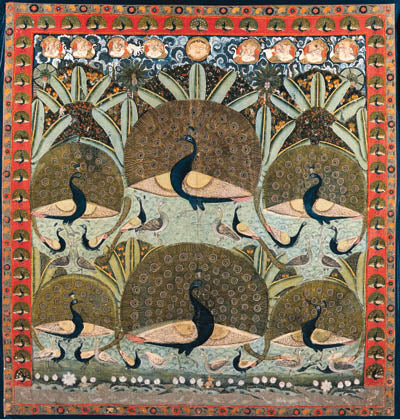
A Pichhavai of Peacocks India, Rajasthan, 19th Century. Image courtesy: Christie's
Brightly painted with cavorting peahens and peacocks, six with plumes unfurled in a garden setting with flowering and fruit bearing trees and scampering monkeys, a lotus pond below with swimming fish, and with flying deities above in chariots driven by geese and mythical creatures, bordered by peacocks and floral sprays on an orange ground.

This group of mosaics may be from a church at Maaut El Naaman in northern Syria. The panel depicting Adam and Eve includes a Greek inscription that translates as: "And they ate, [and they] were made naked," from the book of Genesis (3:7–8). It is possible that the mosaic belonged to a pavement illustrating the Garden of Eden. The Grape Harvester with a Peacock also conveys well-known Christian themes. The grapes represent the Eucharistic wine and thus the blood of Christ, while the peacock was a symbol of immortality. Image courtesy: Wikimedia
Also read: The Best of Best Animal-inspired Jewelry
Jewelry
Cartier

An onyx, Emerald, sapphire and Diamond ‘parrot’ ring by Cartier, circa 1995. Image courtesy: Bonhams
The sculpted feathers pavé-set throughout with brilliant-cut diamonds, with an additional brilliant-cut diamond carved sapphire and emerald plume, the eyes set with circular-cut emeralds and the beak of carved onyx, diamonds approximately 3.50 carats total, signed Cartier, maker's mark, numbered 47926, ring size O (sizing band) The animal kingdom has inspired Cartier's designers since the firm's inception. A veritable bestiary, including panthers, tigers, crocodiles, birds, snakes and even a poodle, has graced the necks, lapels and fingers of Cartier's soigné clientele. From the early 1980s, Creative Director Micheline Kanoui, has continued in the illustrious footsteps of Charles Jacqueau and Jeanne Touissaint.
Jar

A gold, Diamond and green Garnet ‘parrot tulip’ bangle, by Jar, 1994. Image courtesy: The Jewelry Editor
Designed as a sculpted gold flower, the two petals at the base forming the hinged cuff, enhanced by single-cut diamonds and circular-cut green garnets
It achieved $3,595,853 at Christie's Geneva Magnificent Jewels auction in November 2014 - the second highest price achieved for one of the jeweler's creations.
Also read: Custom-made Jewelry vs Ready-made: Who Will Win?
Mellerio Dits Meller

An antique Diamond and enamel peacock aigrette,
Mellerio Dits Meller, dated - 1905, part of the grand collection of the "Maharajas & Mughal Magnificence" auction by Christie's. Image courtesy: Tumblr
Worked in 18k gold, rose-cut diamonds, blue, green, yellow and golden brown enamel, signed Mellerio dit Meller, this aigrette belonged to Maharaja Jagatjit Singh of Kapurthala and Anita Delgado.
In December 1905, before heading to the royal wedding of King Alfonso XIII and Princess Victoria Eugenia of Battenberg in Madrid, the Maharaja Jagatjit Singh of Kapurthala went to Paris to prepare for the event. A great connoisseur of the French art de vivre and culture, the Maharaja was an important client of the jewelry houses of Place Vendôme and Rue de la Paix. Looking for spectacular jewels, worthy of a royal wedding, he entered the Mellerio boutique on December 7th, where he discovered the perfect jeweled ornament. On his quest for an appropriate jewel, the Maharaja of Kapurthala found at Mellerio a magnificent enamel and diamond peacock aigrette. The peacock, that mythical animal venerated by numerous civilizations and especially by India, had been a favorite of Mellerio ever since Empress Eugenie had commissioned a peacock feather brooch in 1868. Emblematic of their artistic repertoire, the bird motif justified the combination of blue and green, which was unconventional in the jewelry of the day. The aigrette purchased by the Maharaja presented the perfect combination of Indian influence with a Western vision. The Maharaja probably wore the aigrette on his turban at the royal wedding at the end of May 1906, where, during the same visit, he incidentally met a young Spanish flamenco dancer, Anita Delgado. She would become his fifth wife less than two years later. The peacock aigrette, linked to their first encounter, was later seen worn by Anita Delgado, known as the Maharani Prem Kaur Sahiba after their marriage.
Mughal Indian

A Mughal gem-set gold mounted Jade pendant (Haldili) India, late 18th/early 19th Century. Image courtesy: Pinterest
Cartouche-shaped, inlaid with gold and set with cabochon-cut rubies and emeralds and tablet-cut diamonds in a three-stemmed symmetrical floral motif emanating from a small oval ruby, with two birds in profile flanking the central diamond, drilled for suspension.
A Haldili is a pendant amulet worn to control involuntary palpitations of the heart. Haldilis are usually decorated with a linear, conventionalised, symmetrical branching tree-of-life pattern, emanating from a vase. The gem-stones are possibly a reference to fruit or flowers on the tree of life.
Also read: All You Need To Know About the History of Choker Necklace
Aurus

On the left: the regal Padmini Thussi necklace, worn by a Maharashtrian bride—handed down from generations influenced from the jewelry styles of Kolhapur.
On the right: the majestic Leela Peacock necklace. Sacred, the peacock is also considered to be the only bird with the courage to fight cobras, rendering this necklace no less than a metaphor for a self-confident woman wearing her dazzling finery.

On the left: the gorgeous Diya Jaisalmeri Necklace, featuring a classic silhouette with an ornate center that portrays intricate motifs of peacocks.
On the right: the elegant Shirali Necklace, Strung on lines of pearls accentuated by tourmaline and emerald drops, two peacock motifs beautifully meet in the center of this piece. Perched on a crescent, the peacocks face each other and are detailed with kundan-set gemstones and textures on gold.

On the left: a contemporary twist to the culturally-rooted motifs, the Pankh Necklace features a gem-encrusted pair of peacocks that perch by the neck, radiating luxury with a finely set polki center.
On the right: a medley of colors, craft, and culture, the Parakeet Necklace features an iconic parrot motif comes encrusted with uncut diamonds, handcrafted on gold.

On the left: the Sajni Mangalsutra—a step away from traditional mangalsutras, modern, yet rooted in culture.
On the right: the iconic Guttapusalu Necklace speaks volumes about how jewelry is art and holds cultural and regional historical value. It is an ode to its origins along the Coromandel coast.
References:
https://www.vam.ac.uk/articles/chinese-wallpapers-and-the-chinoiserie-style
https://www.metmuseum.org/art/collection/search/39737
https://www.clevelandart.org/art
https://www.clevelandart.org/art/1953.330#
https://www.bonhams.com/auctions/23403/lot/84/
https://www.christies.com/lotfinder/Lot/a-gold-diamond-and-green-garnet-parrot-5844881-details.aspx
